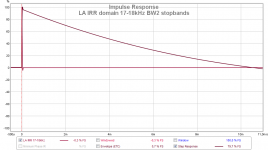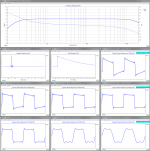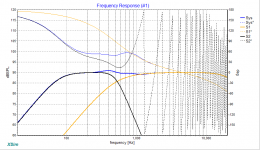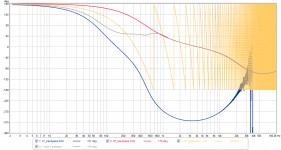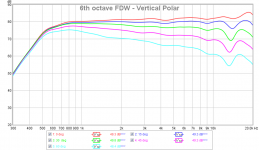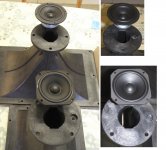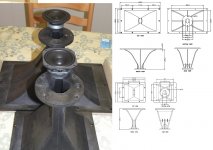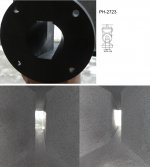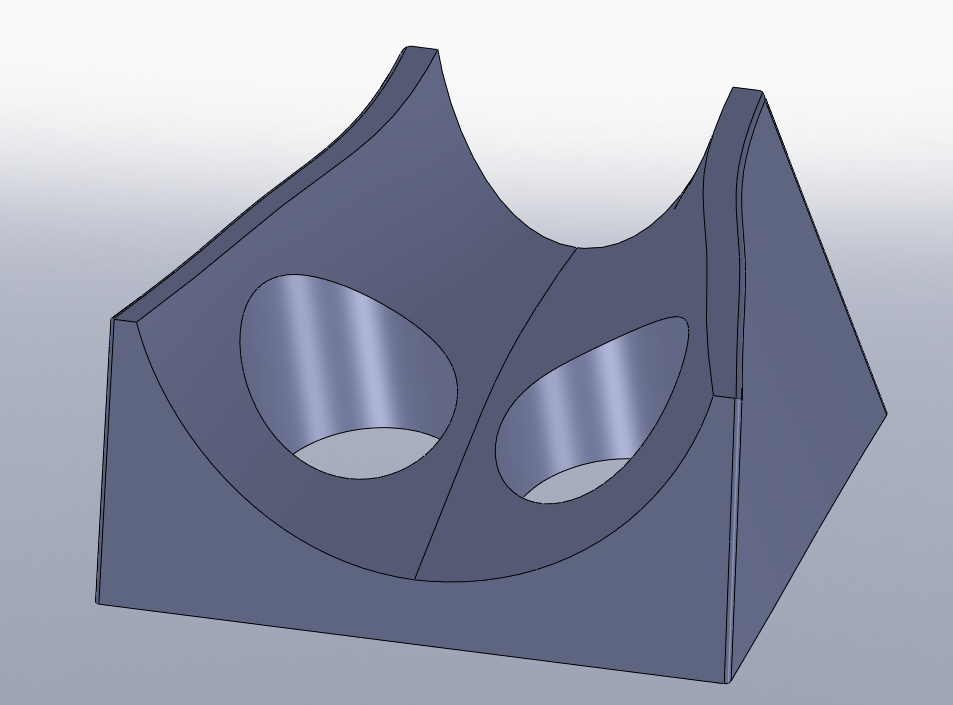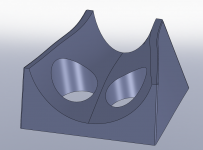Bushmeister used REW auto EQ and I did manual. I wonder of it was the auto tune that helped him get flatter phase. My phase is aril tilted.
Or is that the waveguide design? The 18Sound is some super elliptic vs mine is a tractrix?
Think your phase looks pretty normal as IRR phase, after a sweep hit "Estimate IR delay" then "Generate minimum phase" and if those two phase is fair same without too much excess phase must point to settings for EQ correction is pretty good repair in IRR domain.
Phase goes lag 90º per order of low end roll off and if one turn of setting for phase wrap its easyer to to see where it cross every 90º order and yours looks like crossing +90º in 440Hz area, same 90º per order happen in HF roll off area but in minus advance, but we can't see much of that in real because of our bandwidth limit at 22,05/24kHz.
Phase bushmeister showed before listening test was with woofer that flatten and extends lowend so can't be compared to SB65 alone, below is a modeled IRR EQ amplitude fair close to your acoustic real world and phase looks show same.
Attachments
Thanks Byrtt! Your filter time-bandwidth modeling is really handy. I think you should start a thread showing us how to do this. 🙂
I feel better now knowing my phase isn't all messed up. I forgot not having a woofer there prevents it from being flat.
I feel better now knowing my phase isn't all messed up. I forgot not having a woofer there prevents it from being flat.
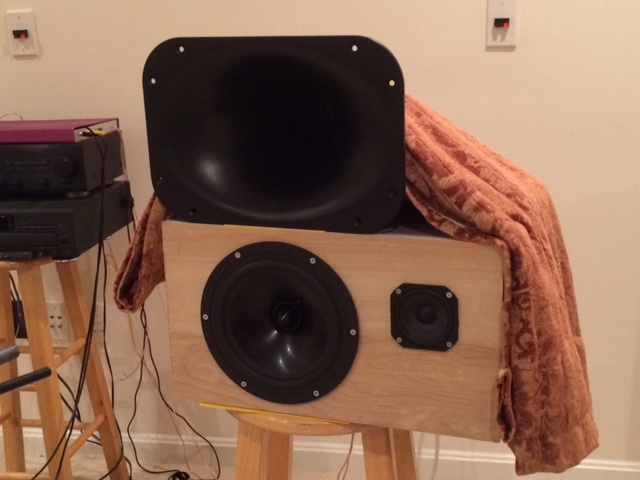
For grins I wanted to get a sense of how music sounds on it so I put together a FAST with the sealed 14 liter RS225-8 as a woofer.
Very difficult to compare your work with bushmeister's when you are clearly using different blankets.😉
Those are actually chenille corduroy drapes - perhaps wool would have better damping effects? 😀
Listening to some more music. Varied genres all sound good - speaker's flat reaponse is working out well. The limited 60deg x 50deg directivity really improves the sound quality in my rather lively untreated room.
Interesting note is that the horn has to be level attenuated -14dB to match the single RS225.
Listening to some more music. Varied genres all sound good - speaker's flat reaponse is working out well. The limited 60deg x 50deg directivity really improves the sound quality in my rather lively untreated room.
Interesting note is that the horn has to be level attenuated -14dB to match the single RS225.
Last edited:
The flat Fr and Phase of Bushmeister's setup makes me think he's not having a true Harsch x-over as we know it. Way too coherent both in phase and FR.
I said it before and stand by it. Forget about names in crossovers and let them do the best job possible. To me bushmeisters attempt seems to do just that.
We might want to look at phase and FR under all angles to be sure.....
Yes and Harsh is very complicated where its phase is and where not inside XO point area, look below REW phase plot which think is more correct than XSim. Red and blue is real phase for each LF and HF band pass, then 1mS is added to red HF resulting in orange wrap that sum with blue as greay trace shows. In XSim even its yellow HF driver that has delay added it shows as black LF is wrapped with a delay change but at least blue system phase is right sum. Complicated power response in XO region did seem to suit bushmeister's phase at his dirty quick trail setup, lets see when one more woofer is installed pointing to the other and maybe add more symmetrical forward throwing direction as also tweeter fire, and how it then looks.
: ) find IR-wav files to fun with for that Harsch config, import to REW and offset SPL a same value for both files if needed and "Estimate IR delay" is important. Set imported HF bandpass IR a -1mS (minus) and sum file "1 + 2" in "SPL" window and once again important to "Estimate IR delay" that new sum. For use in XSim export the two SPL and IR zero time offset band passes as frd-files and link FRD's to two parallel coupled drivers, as delay either set -13,5inch mod delay on woofer and it works, a second choice is set tweeter +13,5inch mod delay but then Amp needs a -13.5inch mod delay for plot to show right system phase.
.....BYRTT, you're not being entirely fair to me. Yes I stated I want the minimum phase over the entire bandwidth. But my system doesn't exactly roll off at 100 Hz now, does it? 😉
It is flat phase down to 40 Hz, the difference is in the area below 40 Hz. I hear a difference between linear and minimum phase for that last bit of a turn.
The linear phase sounds a bit "hasted" and "pressured", the minimum phase sounds more natural. It has extension in SPL down to 17 HZ at least. I think that makes a difference 🙂.
In other words, the linear phase correction makes me feel "jumpy". Like I'm trying to catch a bus or a train...
Regarding system roll off stop bands as IRR or FIR pretty sure yours are superior to mine, better documented, measured at listening position and tuned to natural. Plots was to show visual wave shape and possibilities not what works best for individuals environment and setup.
Agree its not fair give impression line arrays roll off at 80Hz as those plots did, and hope not i did because explained the lack of sub and AC domain closer to DC component. To see how impressive a wideband IRR domain 17-18kHz looks in wave shape 😉 find below XSim multi plot plus REW IR/SR.
Our house curve is probably very different mine is only falling -3dB with rising frq and in lows because box up at wall roll off starts relative high with slow falling slope and as is works with FIR at stop bands.
Attachments
Last edited:
I just rotated the WG 90 deg so that it has 50 deg H x 60 deg V and it doesn't sound so bad. Actually it sounds better with more latitude for sitting and standing sweet spot and I prefer less dispersion in horizontal. It is now a slim 9.5in wide speaker - qualifies as a bookshelf for sure 🙂 This could change everything. Hmmm....
Need to take polars in this orientation.
Edit: here are "vertical" polars (actually WG rotated on axis 90 deg and taken horizontally).
I don't know - looks very good to me. I think I may go with this orientation.
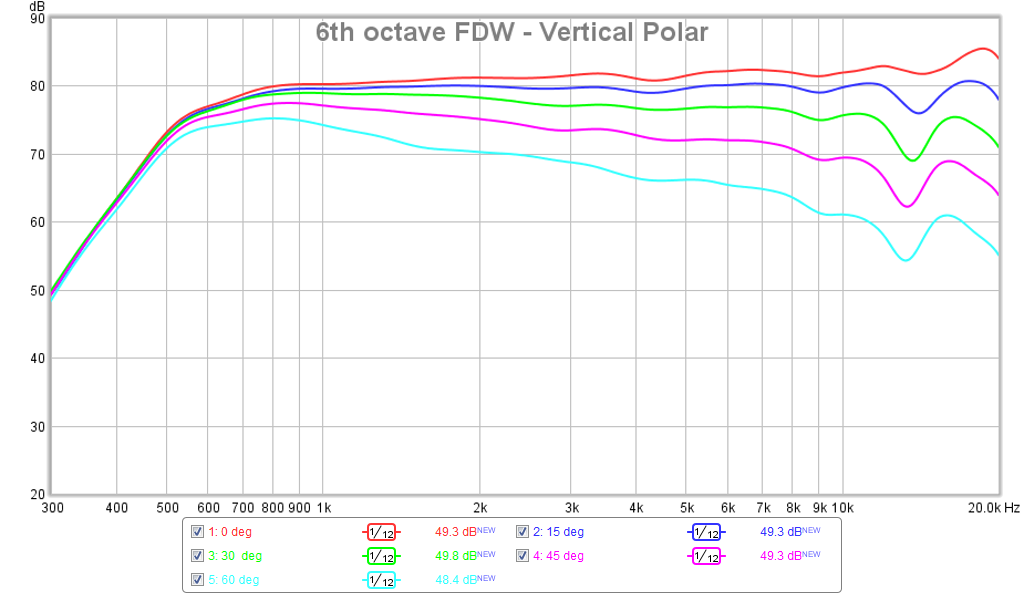
The difference in the behavior at 500-700Hz may be a baffle effect of having the speaker with a narrower baffle now that it sits vertical and doesn't have the assistance of the wider woofer box underneath it.
For ease of comparison, here are the "Horizontal" polars:
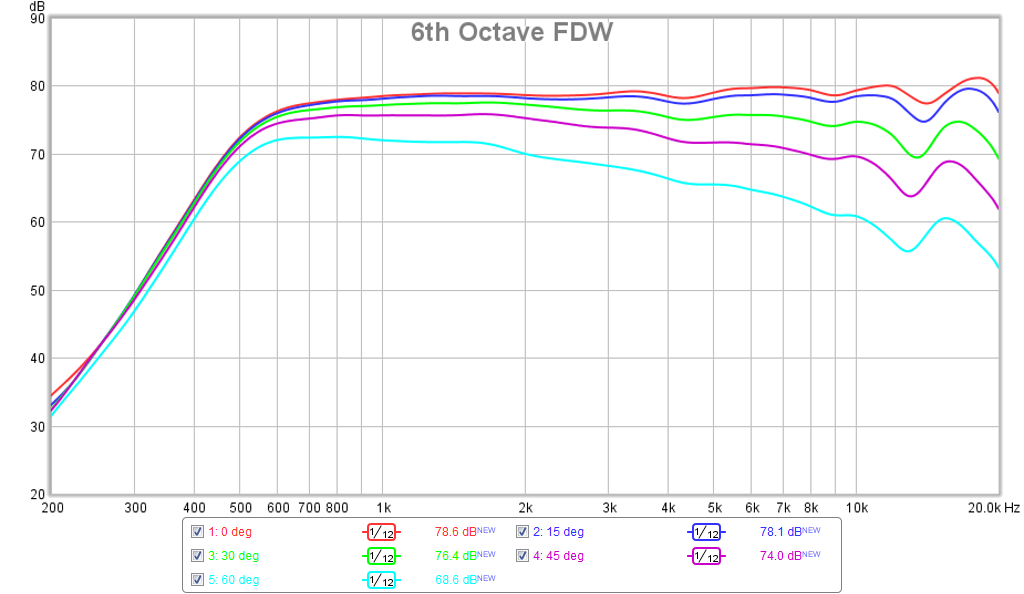
Need to take polars in this orientation.
Edit: here are "vertical" polars (actually WG rotated on axis 90 deg and taken horizontally).
I don't know - looks very good to me. I think I may go with this orientation.

The difference in the behavior at 500-700Hz may be a baffle effect of having the speaker with a narrower baffle now that it sits vertical and doesn't have the assistance of the wider woofer box underneath it.
For ease of comparison, here are the "Horizontal" polars:

Attachments
Last edited:
This JBL 2380 clone has a very pronounced undercut (pinched) throat, required for the wide dispersion pattern, which may be too much for a full range driver too "push" through. I'd expect the high frequency polars to be erratic, and HF sensitivity to be several dB less than the native on axis sensitivity of the driver chosen.What do you guys think of using the P.audio ph-2380 in such an application?
That said, the 2" throat with a driver the diameter of an SB65 may result in less throat transition related peaks and dips than the 1.4" horns used by xrK and Bushmeister, so won't require the throat adapters/treatments.
The JBL 2386, which has very little undercut, seems to work well:
http://www.diyaudio.com/forums/full-range/205146-2-madness-hornloading-tb-w2-803sm-7.html
There were quite a few of those available from Clair Global for just $35, if you can live with the 40x 20 pattern and deeper depth, it would be a better choice, and considerably more sensitive.
Art
Remember my post mentioning the Eminence H2EA waveguide used vertically? That's a 2" horn that might be a bit easier to integrate with a small fullranger.
You prefer more floor and ceiling reflections than side wall reflections?I just rotated the WG 90 deg so that it has 50 deg H x 60 deg V and it doesn't sound so bad. Actually it sounds better with more latitude for sitting and standing sweet spot and I prefer less dispersion in horizontal. It is now a slim 9.5in wide speaker - qualifies as a bookshelf for sure 🙂 This could change everything. Hmmm....
Need to take polars in this orientation.
To each is own 😉...
The mid dispersion in the nominal 50 degree direction is actually wider below 1200 Hz (or so), hard to say what you are finding "better". The HF polars in the 60 degree orientation show progressive beaming, will be interesting to see the 50 degree orientation polars.
You wrote:
"the horn has to be level attenuated -14dB to match the single RS225".
You are using almost that much boost in your DSP. The horn gain in the 400-1kHz range is real, of course, but the on axis response at 10kHz is only 83 dB 1watt 1 meter, just a bit less than the native response of the speaker on a standard baffle.
The chenille corduroy drapes suggest you may not yet fitted a compression chamber on the SB65, lack of which might be partially responsible for the "interesting" phase response.
Art
Remember my post mentioning the Eminence H2EA waveguide used vertically? That's a 2" horn that might be a bit easier to integrate with a small fullranger.
One problem is that it is cast aluminum - more difficult (not impossible) to drill through. It is also only 6.5in long so tough to fit a 8in woofer onto it.
You prefer more floor and ceiling reflections than side wall reflections?
To each is own ...
I was surprised I thought it sounded better too - it must be that I like it to have more of a vertical sweet spot. Dunno... I am proceeding with it also for reason that it is now a narrower baffle.
Thanks Art and BYRTT. Looking forward to seeing your experiments, BYRTT. P.audio is available here in Norway, so if it works I might follow in your footsteps!
What do you guys think of using the P.audio ph-2380 in such an application?
Cookiemonster,
Great to see you are going to work on this too. The PH 2380 looks like a great candidate for a larger 3.5in driver like the SS 10F/8424. The overall horn length is 9.4in which should have enough room to mount an 8in woofer. The low end on this horn seems to go down to about 600Hz which is sufficient - mine is sort of about there too. One thing to watch for is that this horn has a slit throat and that may make diffraction - but maybe the basis for the very wide dispersion of 90deg.
Good luck!
xrk971
Tech info here for those interested...
http://www.p-audio.co.uk/pdf/PH-2380.pdf
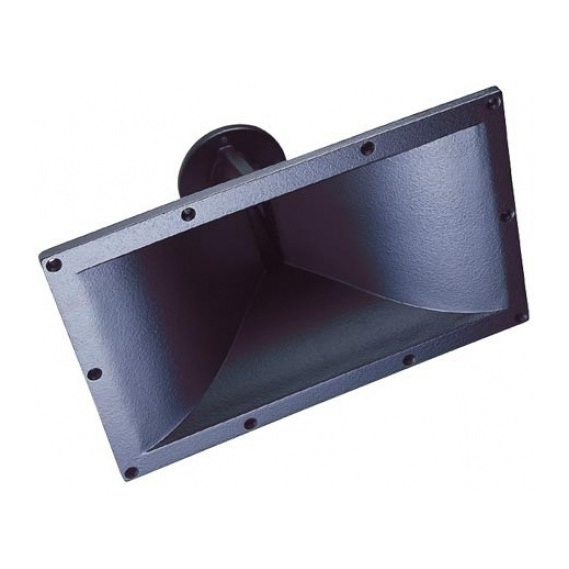
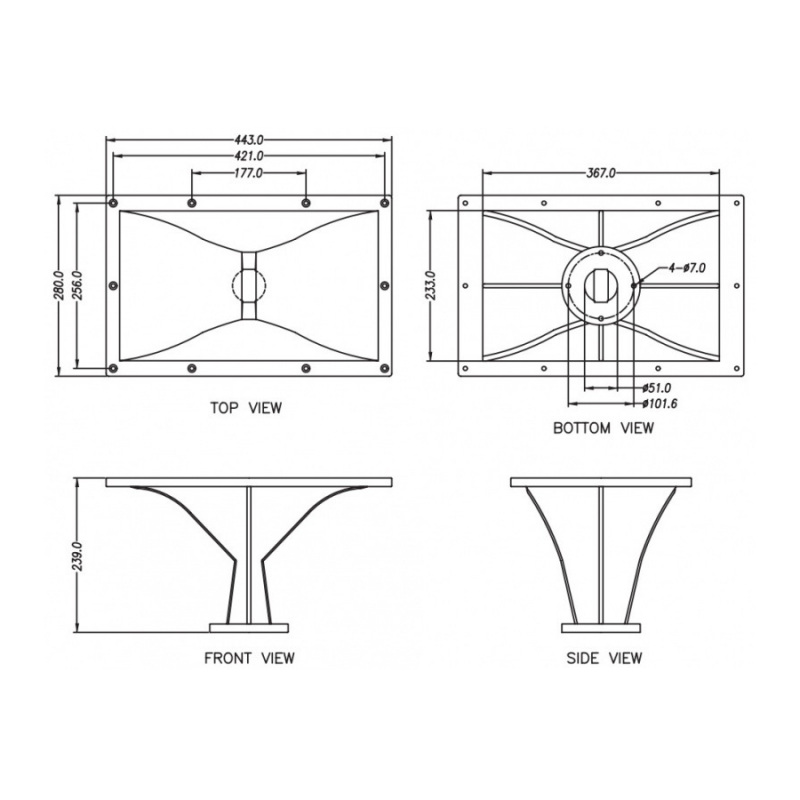
Last edited:
X: It seems like a great way to get a point source horn without the complex woodworking. Good work done so far! Art also seems to think the slot will mess up the hf polars. I suppose i dont really need 90 degrees horizontal, so the 4528 is a better choice. I will wait to see what BYRTT posts and if it looks promising order a pair. I suppose a 2" opening will give lots of flexibility too (print new adapters for different drivers..)
PH-2723 / 4528
cookiemonster77,
Her some picture to show light on dimensions, horizon throat entrance is a round 48mm diameter that narrow down like a mandrel, vertical throat entrance is a rectangle 52mm in height.
Not shure how easy this would be and if it will work but think SB65WBAC25-4 that arrive this week would be easyer to adapt to that 48/52mm entrance. If a home made adapter smooth shall follow scheme of horn entrance the round part in adapter shall expand with direction to cone, but the rectangular part shall shrink in direction to cone.
cookiemonster77,
Her some picture to show light on dimensions, horizon throat entrance is a round 48mm diameter that narrow down like a mandrel, vertical throat entrance is a rectangle 52mm in height.
Not shure how easy this would be and if it will work but think SB65WBAC25-4 that arrive this week would be easyer to adapt to that 48/52mm entrance. If a home made adapter smooth shall follow scheme of horn entrance the round part in adapter shall expand with direction to cone, but the rectangular part shall shrink in direction to cone.
Attachments
Wow guys - What a lot of builds this thread is starting!
I have just glooped another 1kg of stuff on the horn and cut the mounting plate. So I reckon in 24-48 hrs I should have two woofers fitted.
Although Xrk will probably get ahead if he can get his 3D printer to print some woofer mounting plates too - definitely quicker and less messy.
I am also thinking about getting my table saw out to get cracking on the cabinets if this weather improves...
I have just glooped another 1kg of stuff on the horn and cut the mounting plate. So I reckon in 24-48 hrs I should have two woofers fitted.
Although Xrk will probably get ahead if he can get his 3D printer to print some woofer mounting plates too - definitely quicker and less messy.
I am also thinking about getting my table saw out to get cracking on the cabinets if this weather improves...
- Home
- Loudspeakers
- Multi-Way
- A Bookshelf Multi-Way Point-Source Horn

